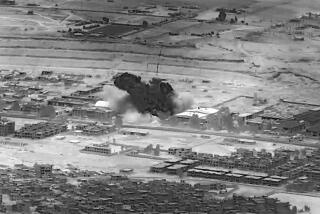Opposition Reports Gains as U.S. Intensifies Strikes
- Share via
TERMEZ, Uzbekistan — As U.S. warplanes stepped up airstrikes in northern Afghanistan, anti-Taliban forces claimed Tuesday that the front-line bombing had helped them score significant gains in their campaign to capture the symbolically important city of Mazar-i-Sharif.
Officials of the opposition Northern Alliance said their troops had advanced to within six miles of the northern city, which three anti-Taliban groups are approaching from the west, south and east. The opposition now plans to spend some time organizing its effort before trying to take the city, Kuodratullo, an aide to Northern Alliance commander Gen. Ata Mohammed, said in a satellite telephone interview.
Although an opposition offensive has been widely expected, the claims could not be immediately confirmed. In Washington, Defense Secretary Donald H. Rumsfeld said he wants to “let the dust settle” before commenting on the reports.
Rumsfeld also said he wants to nearly double the pace of airstrikes from what it has been in recent days, and a senior military official disclosed that the United States is supplying the anti-Taliban forces with weaponry in addition to ammunition, food, cold-weather gear, water and even horse feed.
U.S. officials have been eager to see the anti-Taliban forces make a ground advance before winter, especially because international support for the war appears to be diminishing in the absence of visible results. Seizing Mazar-i-Sharif, which fell to the Taliban in 1998, could open important supply lines to the north, isolate Taliban forces and create a buffer between the Taliban and Afghanistan’s northern neighbors of Uzbekistan and Tajikistan.
Kuodratullo said Northern Alliance forces took the village of Aq Kupruk to the south and drove Taliban troops from the lower and upper villages of Keshendeh, also to the south. His account matched that of Northern Alliance officials in Tashkent, the Uzbek capital, who said 100 Taliban soldiers were killed and 100 captured during the fighting.
Northern Alliance commanders pushed to take Mazar-i-Sharif last month, but the offensive failed because of a lack of ammunition and coordination among the three main commanders--Ata, Gen. Abdul Rashid Dostum and Abdul Wahid.
In recent days, U.S. forces have sharply stepped up their bombardment of Taliban troops on the front lines facing the Northern Alliance around Mazar-i-Sharif and have sent in Special Forces troops to help direct airstrikes, coordinate resupply efforts and provide other assistance.
In this case, however, the Northern Alliance forces didn’t rely on U.S. advisors to direct strikes but rather provided the location for the strikes, according to Kuodratullo, who uses only one name. He said the Northern Alliance advance was helped by “very heavy aerial bombardment. . . . It helped a lot.”
Kuodratullo said that over the weekend, several U.S. helicopters delivered small-arms ammunition to the town of Dara-i-Suf, about 55 miles southeast of Mazar-i-Sharif. It was the first report of direct deliveries of ammunition in the Mazar region; in recent days there have been reports of similar deliveries in Northern Alliance territory north of the capital, Kabul.
In Washington, a representative of the anti-Taliban forces, Haron Amin, said the Northern Alliance troops plan to move on Mazar-i-Sharif in the next several days. But he said the troops will require continued strong air support from the U.S. forces to advance.
At a Pentagon briefing, Marine Gen. Peter Pace, vice chairman of the Joint Chiefs of Staff, said U.S. forces are providing weapons to the Northern Alliance. He declined to describe them.
But Amin said the weapons may be Russian-made RPG-7s. These are rocket-propelled grenade launchers, which the opposition forces have requested to help destroy tanks as they begin their offensive.
In his comments at the briefing, Rumsfeld appeared to be trying to dampen expectations that the opposition forces would soon sweep through Afghanistan.
He predicted that the Northern Alliance offensive “is not going to be a steady march forward across the front; it is going to be probes and pushes and successes and steps back. That is the nature of it, and I think we just have to face that fact.”
Rumsfeld said he would like to raise the tempo of the airstrikes to about 120 sorties a day, nearly double the pace of recent days.
Because of bad weather and maintenance needs of two aircraft carriers in the Arabian Sea, the rate had been limited to about 60 flights a day, he said. But 120 sorties, he said, is “a more appropriate level, as long as we have the targets.”
Pentagon officials, who have been using a wider variety of weapons against Taliban troops, said they have begun using an antipersonnel bomb called the “daisy cutter.” Pace said that in the past week, U.S. forces have been using the 15,000-pound device, which has been called the world’s most powerful nonnuclear explosive.
“They make a heck of a bang when they go off,” Pace said. “And the intent is to kill people.”
Rumsfeld also sought to rebut charges that a number of U.S. soldiers were injured, some seriously, by the Taliban in the first special operations raid of the war, which took place 2 1/2 weeks ago. He offered a long list of injuries from the raid but said none were from enemy fire.
Parachute jumps had caused two broken foot-bone injuries and 23 other minor injuries, such as cuts, Rumsfeld said. Five other soldiers were injured when explosives used to break open buildings sent fragments of concrete and other materials flying. One soldier broke a finger, he said.
Officials denied a report that a U.S. helicopter had been shot down in southwestern Pakistan on Sunday.
*
Reynolds reported from Termez and Richter from Washington.
More to Read
Sign up for Essential California
The most important California stories and recommendations in your inbox every morning.
You may occasionally receive promotional content from the Los Angeles Times.














